36. The wrong shot
Had my chance come a few minutes sooner, I might have killed the buck. It was a gorgeous high-country deer, heavily muscled, with a gray coat, grizzled face and thick, broad mahogany antlers. I’d been on its trail all day, tracking through patchy snow and soggy meadows, cutting fast across basins, glimpsing movement twice—too far and too quickly gone. The buck had stayed along the rims, just above timber.
Now dusk had come, and with it a brute of a storm, borne by a cold, keening wind. Deep-violet clouds turned black as they enveloped the mountains to the west. Sheets of snow tumbled like a curtain to hide the Wallowa Valley. I’d have to descend soon.
The deer appeared below me, silently. It wasn’t moving now, just standing, regarding me as if to say, politely, “This is where we part.” I eased the rifle up as the storm hurled itself onto the slope, popcorn snow pelting me and the wind wresting the rifle off target. I wanted badly to fire. But I didn’t.
Neither did I shoot at the biggest elk I’ve seen in 35 years afield. The bull faced me 300 yards off, at the far end of a meadow. Ivory tines reach high and wide, Prone, it was a makeable shot—heck, it was a cinch. But I wasn’t prone, couldn’t get prone or even sitting without losing the elk below the hump of the ridge. Offhand, the crosswire bounced crazily, on and off the chest. As it had with the deer many seasons before. Again, I considered the odds and declined. A lethal hit shouldn’t depend on good luck.
Long shots require precise shooting more than they beg powerful loads and optics. If you can’t steady the reticle, shooting is simply an exercise in hope. Declining a shot, you reveal standards. Without them, the decision to fire depends only on how badly you want to kill.
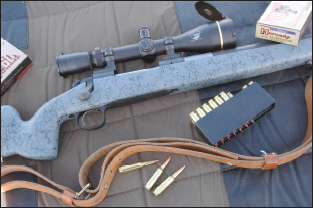
Before hunting with his Magnum Research rifle, the author shot it extensively at distance, prone.
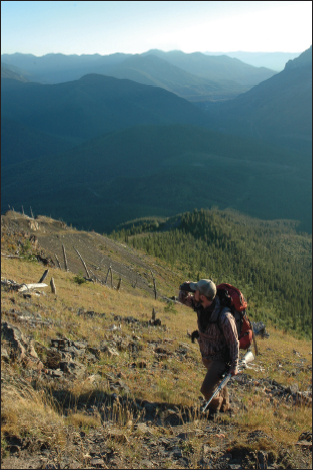
Big country suggests long shooting. But short shots are usually possible, almost always easier.
Risky shots aren’t all long. Once, still-hunting through thick lodgepoles, I caught a wink of russet color. In the Leupold it became an elk ear, 18 steps away. I was not gulping air; the reticle quivered, but in a tight, controlled way like an eager shorthair anticipating the shot. Problem was, brush blocked the bullet’s path to brain and spine. I could only guess where the shoulder lay. Seconds later, breeze kissed the back of my neck. The ear vanished.
No one can specify a sure-kill distance for shots at big game, as no one can declare a maximum speed safe on a highway. Conditions matter. Hunters who boast of long shots may in fact be conscientious—a long lethal hit is no less legitimate than one taken up close. Arguably, sniping from afar diminishes the thrill of the chase; and the cynical might say a habit of reaching beyond point-blank range indicates you’re lazy or inept. But neither long shooting nor fast driving is irresponsible of itself. Years before distant shots at game became fashionable, I rolled a deer at roughly 480 yards, judging by bullet drop. The hit—through the heart—followed two misses with my .30-06. The buck looked very small in my 4x scope, and I had to double my initial allowance for drift. The killing shot was a good one, intelligently engineered and well executed. It was also as reprehensible as the first two. These days, I fire only when 90 percent sure of a kill—that is, when under prevailing conditions I can expect to land a bullet in the vitals nine times in 10 tries.
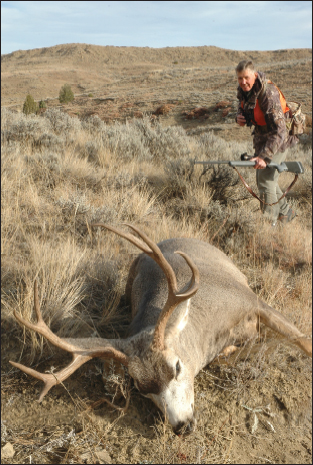
Long shots aren’t reprehensible if they’re lethal 90 percent of the time. Short shots aren’t all easy.
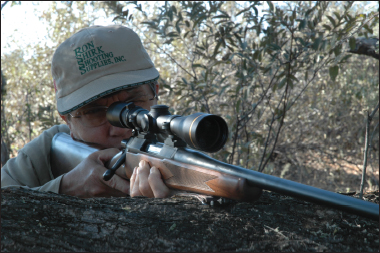
Bonnie Shirk rests her rifle on a log for a long shot. Accuracy at distance requires a steady rifle!

Her first African trophy! Donna Gulden waited for a good shot at this gemsbok, fired carefully.
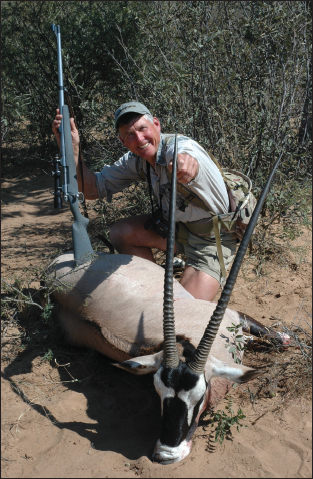
After a long crawl to within 90 yards, the author killed this gemsbok with a .375, Africa’s darling.
Distance is only one of several factors that influence a shot. Of course your hardware has limits. But rifle, cartridge and optics seldom count for as much as shooting position and shot execution. Wind matters most at long range. Steep angles, quartering presentations and intervening brush can scuttle shots up close. So can other animals in the background.
“Anyone who says he wouldn’t take a risky shot at a big bull on the last day is a liar!” A reader once posted me that note, after I had suggested that neither an animal’s trophy value nor the likelihood of another shot qualify as conditions. If your aim is to kill, only variables that affect the probability of a lethal hit matter. Wishing that you’ll kill doesn’t justify a shot any more than wishing earns you a gold medal, a winning lottery number or a PhD.
Shooting when you’re not sure of the shot is like poaching in this way: Both events show you can’t abide discipline. Hewing to standards in shot selection is like obeying game laws. You restrict yourself so that, whatever the outcome of a hunt, you will have acquitted yourself well.
Such high ground can be costly to hold. Pass a shot at a records-class animal, and you may have passed the only one you’ll ever have. No shoulder mount. No accolades from pals. No listing in the book. “Your one chance to be a celebrity, and you turn it down—why? Because there’s only a 50-50 chance of killing? Good grief! At least put a bullet in the air! If the shot’s off the mark, no one needs to know….”
If you’re with a guide or a partner, someone will know when you botch a shot—and remember. You might also confront the rule, increasingly common, that blood drawn is a tag filled. Guiding an elk hunter years ago, I spied a fine bull on a distant spine. Quickly we scooted closer. Setting up my spotting scope in a copse of aspens, I was startled by the blast of my client’s .300. He had wanted that elk badly and opened up—offhand—at ridiculously long range. My objection was drowned by his second shot. Grimly, I trudged to where the bull had stood and found blood. We trailed the animal until the blood petered out. Then, because I could not dismiss the wound as superficial, we spent the rest of that week passing up other bulls to find the injured elk. We failed.
If you’re alone, a “first blood” rule still makes sense. You’re not afield to spray the scenery with softpoints and hope something falls over. In its pure sense, sport hunting is testing yourself. It is not simply carcass collection.
Sometimes others in your party may test you too. A guide who really wants rid of your company or to visit his girl or attend Saturday night festivities at Billy Bob’s will want you to shoot early. Ditto an outfitter looking to bump his success rate or spare the groceries or beat a storm. Resisting that pressure can make for a tense camp. But taking risky shots to please your companions won’t sit well in memory.
Once, in Africa, my PH and his tracker led me on the trail of an eland bull. We were all physically fit, but by mid-afternoon, sun, sand and thorn had exacted a toll. Then Komati snapped his fingers. I heard it: the faint click of eland hooves. We crept forward. The tufted face of a huge bull appeared 60 yards away. Slowly the crossed sticks rose, and I slid my rifle into place. But a screen of acacia loomed in the sight.
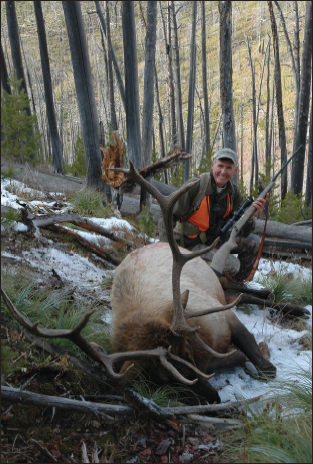
The author used Norma’s .270 Weatherby ammo in a Weatherby rifle to take this bull at 300 yards.
“Shoot,” hissed the PH. “Your bullet will get through.”
I shook my head. A second later the eland vanished. We began a long hike back in uncomfortable silence. As luck would have it, I killed an eland later, a fine bull that dropped to one shot. All was forgiven.
But you’re foolish to count on second chances. Not long ago, on assignment for a television show, I turned my ankle on a rocky hillside and fell so quickly I couldn’t save my rifle from a bruising—a freak event. Of course, our party spotted an elk barely an hour later, quartering away in a small window in dense alder. Ordinarily I’d have bellied down and fired. But there was no divining how my tumble had affected my scope. “Sorry,” I mumbled to guide, cameraman and company. The rest of that week was an exercise in public relations, as no other elk appeared. The scope, by the way, had not lost zero. But conduct matters. A lucky hit on the heels of a risky shot simply means an animal died in spite of your judgment.

A 300-yard shot anchored this fine Alberta mule deer. Longer pokes are usually ill-advised.
Shots at crippled game needn’t meet a 90-percent standard. I recall a partner hitting a grizzly not quite well enough. The bear roared, spun in a tight circle, then dashed for cover. We both let fly, though neither of us would have fired at a running grizzly that was unhurt.
Another time, I took an ill-advised poke at a Cape buffalo. Tense moments, a dash through thorn and several Winchester solids later, the animal died. It was not a neat kill, but once you commit, your task is clear. The time for deliberation is before losing that first bullet.
No matter how confident you are of a lethal hit, be ready to follow one shot with another. Animal reaction to a hit in the paunch often mimics response to a heart or lung shot. Game escapes when hunters reload slowly or don’t reload at all. Fast bolt work can give you a second hit.
Animals that drop instantly worry me; the bullet may have clipped a spinal process, delivering shock that floors the beast but causes no lethal damage. A bullet severing the forward spine or breaking both shoulders yields the same result. You can’t know exactly where the bullet landed, so be ready! Make fast bolt throw part of your practice routine. A handloader, I fight my habit of opening the action slowly to pluck and pocket the empty. Such a delay could one day cost me the chance to finish an injured animal.
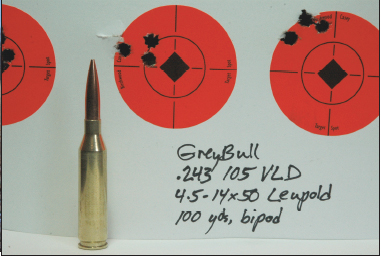
Even the .243 can take big game at distance with 105-grain VLD bullets – and accurate shooting.
The best place from which to fire a second shot is usually where you fired the first. You’re in shooting position, you know the range, you may still have a clear shot alley. If you move forward to close the distance, odds are that a second chance will come quickly, when you’re least able to capitalize on it. You’ll lose time getting ready to shoot and taming your pulse. Terrain or brush may prevent a shot from a low position. Finally, you risk alerting the animal to your location. A rifle’s report and a bullet’s strike give the game little information about you. Instinct tells it to identify a threat before committing to an escape tactic or direction. Stay still until there’s reason to move! A pal once set up to shoot far at a big mule deer, then waited patiently for an hour for the bedded buck to get up and expose a shoulder. Eventually that happened. The bullet struck; the deer rolled out of sight. Wisely my amigo stayed put a few seconds. But that wasn’t long enough. As he climbed through brush toward the bed, he heard the buck scramble off. He never recovered it.
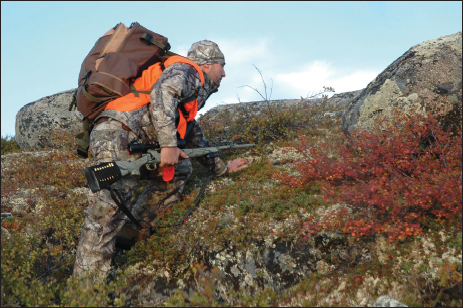
Blake Anderson carries camp on his back in caribou country. Broken terrain affords close shots.
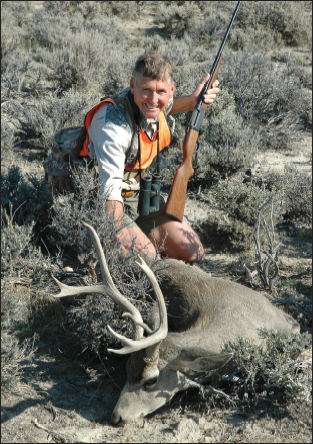
Using coulees and low sage as cover, the author crept up on this buck on its bed. Note iron sights.
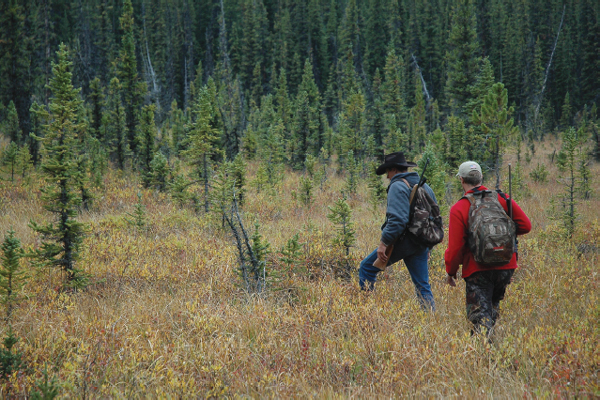
Nimble, lightweight rifles often trump those designed for long shots, especially on long treks!
Once the animal is gone—down or out of sight— your best strategy is to stay still for two minutes. Watch and listen, rifle ready. A delay costs you nothing. Why rush to a carcass? If the beast is ambulatory, silence works in your favor. You can hear movement without revealing your position. Wounded game that thinks it is hidden will likely stay where it fell or bed nearby.
Long shooting is controversial partly because recovering distant game can be problematic. No matter how well you mark the spot, you can lose it after crossing a deep, brushy defile. Off course by a few yards, you may not see that buck. Besides, not all game dies close to the impact site. If you’re nearby, you can hear hooves, twigs, a cough, a stumble. Far away, game that reaches cover in a jump gives you no clue as to its mobility, speed or direction. By the time you arrive, it may have altered its route, found a hidden bed or simply put so much distance behind it that you’ll run out of daylight catching up.
Then there are dolts who don’t check after a shot. They might stroll across a meadow. But lose a quarter-mile elevation and labor up the far side of an abyss and return? “Nah. Probably missed. Won’t find blood anyway. Knees can’t take that. Not enough time.” I’ve found animals shot dead where recovery was probably not attempted. Once, guiding a deer hunter, I spied a buck loafing just 200 yards away, but across a steep coulee. The fellow fired. The deer ran off. I suspected a hit. The hunter insisted he’d missed. I told him we were going to check anyway, and since I had no rifle, he’d have to follow me. Grumbling, he relented. We descended, then climbed to where the deer had stood. Leaving my client to catch his wind, I tracked the deer into cover, where I found a tiny drop of blood. The buck lay dead a few yards farther on.
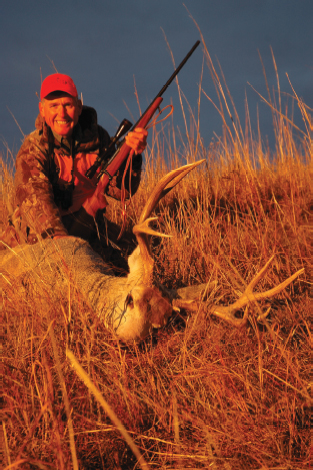
The author killed this Nebraska buck from prone at 100 yards, after a long stalk through tall grass.
Now, it matters not to an animal whether a lethal bullet comes from 50 yards or 500. Nor does shot distance figure into wildlife policy. Harvest is harvest.
It seems to me foolish to measure hunting ethics in yards. I once killed an elk at just over 600—twice as far as any other I’ve shot. My rifle was chambered to a mild round most hunters would think more suitable for deer, even at modest ranges. But it was an accurate rifle, with a scope designed for shooting at extended range. More importantly, I had time to sling up, settle into prone and confirm dead-still air. Most importantly, I had practiced with this rifle on distant targets. My bullet lanced both lungs. Had the elk been a coyote, I’d have hit it.
I’m not especially proud of that kill. I took the shot not because light was fading and an approach nearly impossible, but because it was a 90-percent shot. A 30-yard hit after a long sneak would have been more satisfying; but conditions this time narrowed my options. I could fire or decline.
Those options are yours always, regardless of other opportunity. One evening, hunting kudu, I came upon an old bull browsing in thick thorn. Wind and luck were with me as I edged close for a shot with an open-sighted .470 double. At 23 steps I fired. The animal reeled at the impact, then vanished. I could have emptied my second barrel as the bull suddenly re-appeared, jetting through a gap; but I thought better of it. What if this were another kudu and the first lay dead in the thicket? To my chagrin, the track showed only a trace of blood; In the failing light, I’d nudged the front sight too high in the notch, merely clipping the neck. Apparently 23 steps had been too far.
Another time, in Alaska, I stalked a black bear in tall coastal grass. When the wind spun abruptly, the bear loped toward cover. I rose to my knees, swung and fired. Forest enveloped the bear. My guide was not impressed. My .30-30 he considered marginal at best; now dusk was closing after a hasty shot. We hurried forward. Under a dense canopy, the blood trail—indeed everything—got dark fast. We pushed through giant fern and found the bear dying. My bullet had struck its heart. I breathed a prayer of thanks, and an apology. Success aside, 90 yards had really been too far.
Launching a bullet is properly a weighty decision. Riflemen who shoot cavalierly or beyond sure-kill range boost crippling loss. They also color the public’s perception of sport hunting. Sadly, declining a wrong shot is not as easy as it is noble, because it means foregoing shots that would have killed.
Table of contents
- Title Page
- Dedication
- Copyright
- Acknowledgments
- Foreword
- CONTENTS
- INTRODUCTION
- SECTION I: BALLISTICS IN HISTORY
- SECTION II: THE MUSCLE BEHIND THE SHOT
- SECTION III: BULLETS—THE INSIDE STORY
- SECTION IV: SPEED, ENERGY, AND ARC
- SECTION V : PUTTING BALLISTICS TO WORK
- SECTION VI: FOR LONGER REACH
- BALLISTICS TABLES FOR MODERN SPORTING RIFLES
- GLOSSARY